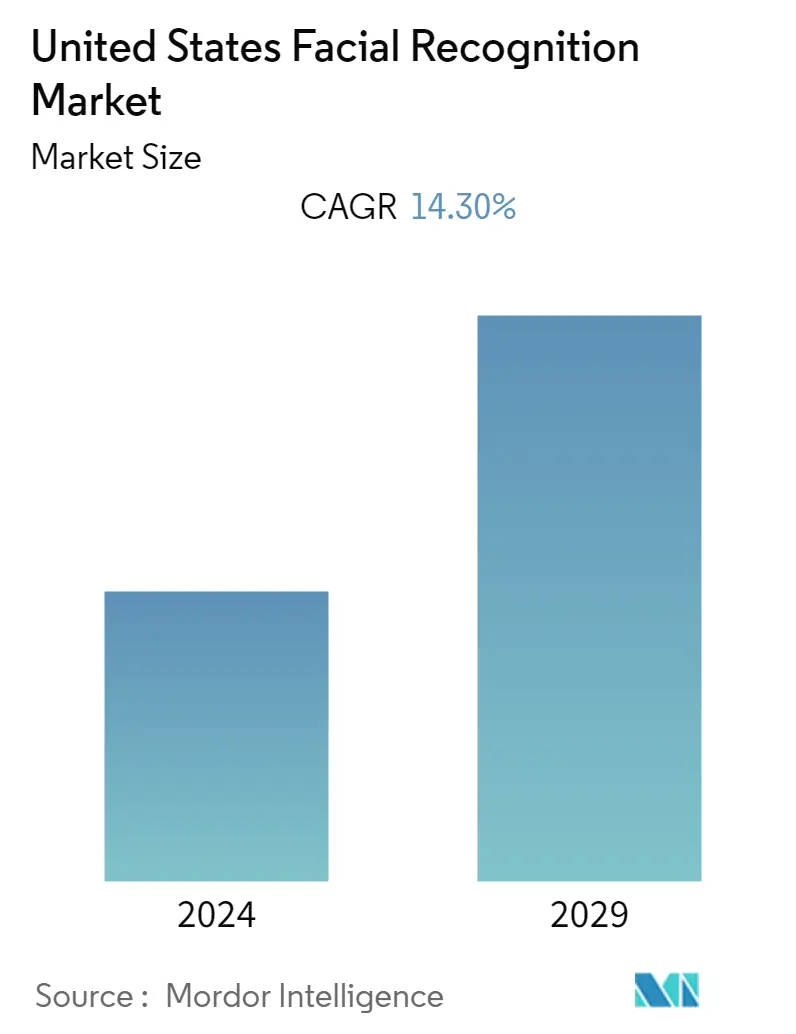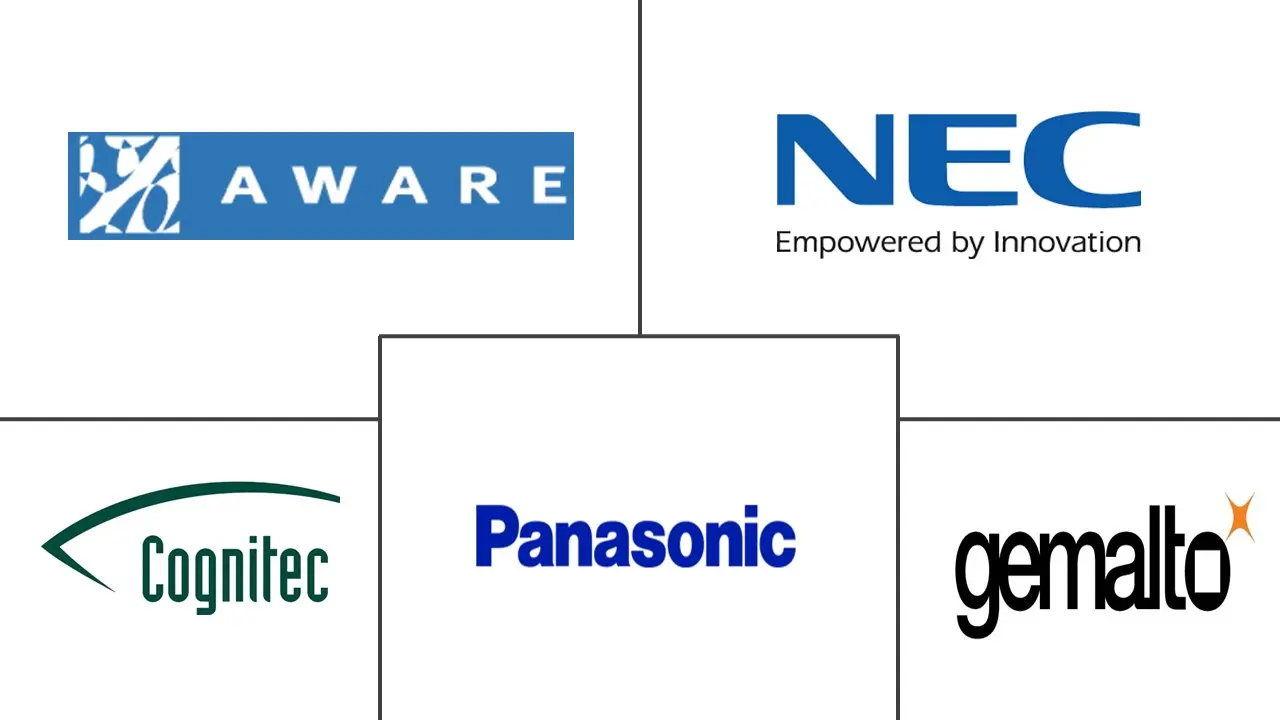Market Size of United States Facial Recognition Industry

| Study Period | 2019 - 2029 |
| Base Year For Estimation | 2023 |
| Forecast Data Period | 2024 - 2029 |
| Historical Data Period | 2019 - 2022 |
| CAGR | 14.30 % |
| Market Concentration | Medium |
Major Players
*Disclaimer: Major Players sorted in no particular order |
US Facial Recognition Market Analysis
The United States Facial Recognition Market is expected to reach a CAGR of 14.3% during the forecast period (2021 - 2026). The United States is expected to hold a prominent share in the facial recognition market owing to lucrative opportunities in the region, exhibiting a massive demand for facial recognition technology for homeland security and criminal investigation.
- Government initiatives are expected to contribute to the double-digit growth of such technologies. For instance, the US government has plans to reshape airport security through facial recognition, to register and identify the visitors. Additionally, several North American Free Trade Agreement (NAFTA) member banks have mandated the use of facial and voice recognition technologies for online identity verification. Companies have also been collaborating with federal governments to implement the technology for their surveillance and identity management.
- Apart from the government, United States companies are also taking advantage of this facial recognition technology. For instance, IntelliVision launched a new version of its facial recognition technology as a cloud service. Face recognition as a Service (FRaaS) offers to match in less than a second and provides analytical capacity when on-camera processing is not enough. Such developments are increasing the applicability of facial recognition in complex business scenarios, thus contributing to the growth of the market.
- As a mass solution, facial recognition is yet to gain increased market penetration, as it has been facing intense competition from fingerprint recognition, voice and Speech recognition, and numerous forms of eye recognition. Enterprises in the market are investing in companies that are operating in the facial recognition space for gaining access to the market. For example, Fico acquired EZCOM and launched new biometric identity solutions to offer better digital security to its customers. Over the coming years, such developments are expected to increase even further.
- The coronavirus pandemic is creating a lucrative market for facial recognition manufacturers. But privacy issues are expected to hinder the growth of the market. Facial recognition technology is being adopted in the United States as a way to track the virus' spread. Also, facial recognition is used as a alternative solution to biometric identification to curb the spread of the virus. For instance, recently, the New York Police Department restrained the use of fingerprint ID entry security procedure by employees. Such developments creating demand for facial recognition companies to step in and market their services as identification alternatives. As a result, facial-recognition companies are focusing on customizing their solutions so that they are better equipped to track citizens who may test positive for coronavirus.
US Facial Recognition Industry Segmentation
Facial recognition is the process of verifying the identity of an individual using feature recognition. It captures the features, analyzes them, and compares patterns based on the person's facial details. The report provides a detailed analysis of technologies such as 3D Facial Recognition, 2D Facial Recognition , and Facial Analytics in various end-user industries.
| Technology | |
| 3D Facial Recognition | |
| 2D Facial Recognition | |
| Facial Analytics |
| End User | |
| Security and Law Enforcement | |
| Healthcare | |
| Retail | |
| Other End Users |
United States Facial Recognition Market Size Summary
The United States facial recognition market is poised for significant growth, driven by increasing demand for security and identity verification solutions across various sectors. The technology is gaining traction due to government initiatives aimed at enhancing homeland security and criminal investigations, as well as its adoption in private enterprises for access control and surveillance purposes. Companies are leveraging advancements in artificial intelligence and cloud services to improve the efficiency and applicability of facial recognition systems. Despite facing competition from other biometric technologies, facial recognition is becoming more integrated into business operations, with enterprises investing in innovative solutions to enhance digital security. The COVID-19 pandemic has further accelerated the adoption of facial recognition as a contactless identification method, although privacy concerns continue to pose challenges to market expansion.
In the healthcare sector, facial recognition technology is being increasingly utilized to streamline operations and enhance security measures. The integration of AI-driven facial recognition solutions is helping to address issues such as patient fraud and medication adherence. Partnerships between technology vendors and healthcare providers are facilitating the development of customized solutions to meet the rising demand for efficient identification systems. The market is characterized by a moderate level of fragmentation, with numerous small vendors and a few key players competing for market share. As the industry evolves, mergers and acquisitions are expected to intensify, further shaping the competitive landscape. Notable collaborations and technological advancements, such as those by FaceFirst and NEC Corporation, are paving the way for expanded opportunities in facial recognition applications.
United States Facial Recognition Market Size - Table of Contents
-
1. MARKET DYNAMICS
-
1.1 Market Overview
-
1.2 Industry Value Chain Analysis
-
1.3 Industry Attractiveness - Porter's Five Forces Analysis
-
1.3.1 Bargaining Power of Suppliers
-
1.3.2 Bargaining Power of Consumers
-
1.3.3 Threat of New Entrants
-
1.3.4 Intensity of Competitive Rivalry
-
1.3.5 Threat of Substitutes
-
-
1.4 Impact of COVID-19 on the Facial Recognition Industry
-
1.5 Technology Innovations & Patent Landscape
-
1.6 Market Drivers
-
1.6.1 Increasing Demand for Surveillance Systems to Enhance Safety and Security
-
1.6.2 Increasing Adoption of Facial Recognition in Consumer Electronics
-
-
1.7 Market Restraints
-
1.7.1 Privacy Concerns and Controversial Claims From Research Institutes and Customers
-
-
-
2. MARKET SEGMENTATION
-
2.1 Technology
-
2.1.1 3D Facial Recognition
-
2.1.2 2D Facial Recognition
-
2.1.3 Facial Analytics
-
-
2.2 End User
-
2.2.1 Security and Law Enforcement
-
2.2.2 Healthcare
-
2.2.3 Retail
-
2.2.4 Other End Users
-
-
United States Facial Recognition Market Size FAQs
What is the current United States Facial Recognition Market size?
The United States Facial Recognition Market is projected to register a CAGR of 14.30% during the forecast period (2024-2029)
Who are the key players in United States Facial Recognition Market?
Panasonic Corporation, NEC Corporation, Aware Inc., Gemalto NV (Thales Group) and Cognitec Systems GmbH are the major companies operating in the United States Facial Recognition Market.

